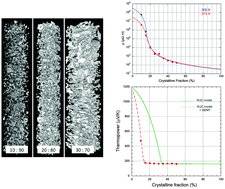Effective medium theory based modeling of the thermoelectric properties of composites: comparison between predictions and experiments in the glass–crystal composite system Si10As15Te75–Bi0.4Sb1.6Te3†
Abstract
We report on the theoretical predictions of the effective medium theory (EMT) and its generalized version taking into account percolation theory (GEMT) on the thermoelectric properties of composites based on Landauer and Sonntag's equations. The results were tested experimentally on composites composed of the glassy phase Si10As15Te75 and the crystalline phase Bi0.4Sb1.7Te3. The evolution of the electrical resistivity and thermal conductivity with the fraction of crystalline phase matches very well the experimental data, although the GEMT model fails to predict the thermopower. A better agreement between theory and experiment could be obtained by combining the principles of the GEMT and the Webman–Jortner–Cohen models. Despite the fact that the GEMT model originally predicts the possibility to optimize the dimensionless figure of merit ZT of composites by adjusting the fraction and the values of the transport properties of each phase, the new model developed rules out any beneficial influence on the ZT values. These results confirm within a different framework the early conclusions of Bergman regarding the impossibility of improving the ZT values using multi-phased materials.


 Please wait while we load your content...
Please wait while we load your content...